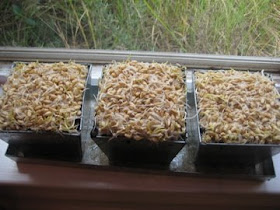While getting prepared for emergencies can be a big task, there are small, easy things you can do every day that can make an emergency seem a bit easier to deal with.
Gas up. Try not to let your car get below half a tank of gas. If an emergency came up and you had to get out of town quickly, filling your car up with gas might be the last thing on your mind. This is especially true if everyone is trying to leave down (natural disaster, etc). You don't want to be one of the people who has to wait in line for 3 hours just to fill up your car.
This came in really handy for me a few months ago. For about 2 weeks after Hurricane Ike, it was rare for a gas station to be open, and when it was, you waited in line for at least an hour to fill up (and paid over $4 a gallon). Thankfully, I had filled up my car right before the hurricane so I was ok, but I had to scale down my trips out of the house, and we only went places we had to go. It was disheartening to drive by dozens of gas stations and see "No gas" signs everywhere. Thankfully, though, we never fully ran out of gas.
Dress according to the weather. This may seem like a no-brainer for most people, but it's actually something I struggle with sometimes! Especially when I was a teenager, I never wanted to wear a big coat to school in the winter, and since I was going to be inside all day I figured it didn't matter.
My parents, however, were adamant that we dress according to the weather. If my car was to break down (a good possibility, seeing as how I was driving a 20-year-old car), I would heavily rely on my warm clothes to keep me safe, and maybe to keep me alive. We had a bin in our mud room full of hats, mittens, and scarves - making it easy for us to be prepared if something were to happen on the road.
Have proper alarms. Obviously, everyone should have a working fire alarm in their homes, but do you have a carbon monoxide detector?
I'm a semi-paranoid person by nature, and it's kind of startling as I think about how much money I fork out for "peace of mind". When I bought a carbon monoxide detector a few months ago, I even splurged and spent $10 extra just for a special feature that shows us the actual amount of carbon monoxide in the air (total cost: $30). I wanted to know at all times!
Last week, however, around 3 o'clock in the morning, the alarm started going off. We noticed that the number on the alarm had gone from its normally constant "0" to over 100. Thankfully we weren't feeling any symptoms (yet), but we threw open the windows and turned on all the fans in the house (thankfully the weather was mild). Slowly, then numbers on the alarm crept down and eventually stopped at 12 (anything under 30 is ok, we learned online).
After a few hours, we were finally able to fall back asleep, confident that our alarm actually worked and that opening the windows had temporarily solved the problem. The next day we called the gas company and they came to our house in less than an hour (and free of charge, on a Sunday!) to check things out. We later learned that they do emergency house calls 24 hours a day, 7 days a week. Good to know, in case this ever happens again!
The point is, if we hadn't had a carbon monoxide detector, I'd hate to think what might have happened. Additionally, if our detector hadn't shown us the amount of carbon monoxide in the air, we probably would have needed to leave and possibly spend the rest of the night in a hotel (which definitely would have cost more than the extra $10 I paid for that feature).
Have a no-electricity day. After reading
Shauna's guest post last week about the ice storm, it really made me wonder how I would do without electricity for a day. The first thing I thought of is that I would be bored (no computer! no sewing machine! no tv!), and then secondly I wondered what (and how) we would eat. We don't have a generator, so my choices with that are limited. I suppose we would just eat out of the pantry - crackers, peanut butter sandwiches, etc.
Consider spending one day in your home (or at least a few hours) without electricity. What are you going to eat? What are you going to do all day? What will your kids do? Do you have enough flashlights for everyone? How will you stay warm? I know this exercise might not sound like much fun, but it's certainly better to do it now - on your own terms - than it would be otherwise. Obviously, you will not be able to go completely without electricity (Shauna said her toilets didn't flush - we're not asking you to go that far!), but at least consider those extra things that you will be without. Hearing that made me realize that we need to get a few 5-gallon buckets for hauling water, if needs be!
Are there any other small things you do to help you stay prepared for emergencies?
 Thank you to Just Organize Yourself for nominating us to the Kreativ Blogger award and
Thank you to Just Organize Yourself for nominating us to the Kreativ Blogger award and





















































